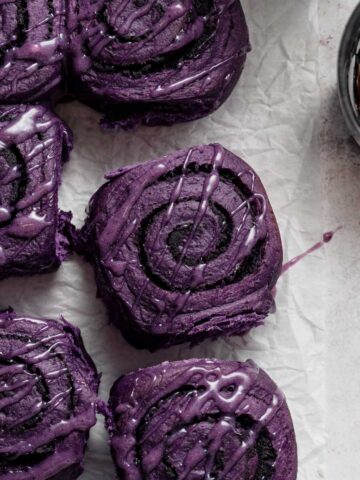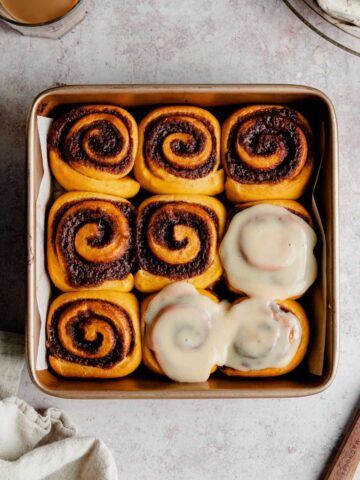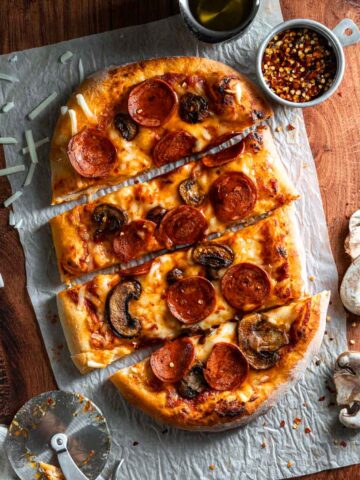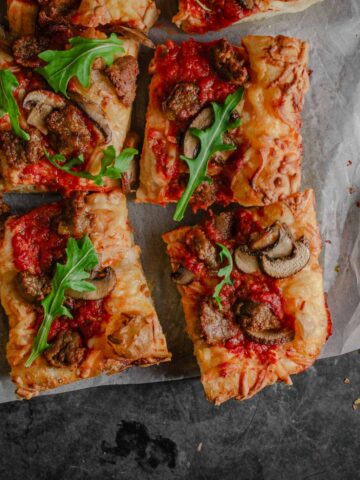Here I am with another Filipino favorite, the classic, the bread roll of the Philippines...Pandesal! These are everything you are looking for in a classic pandesal - soft, airy, and slightly sweet. This recipe obviously requires no egg and is also dairy-free. Just because it’s vegan, doesn’t mean you won't get the same great tasty results! So get your coffee and favorite filling ready because you are gonna want to make this recipe!

What is Pandesal?
Every country has its favorite bread, the French have their Croissants, Italians have their Focaccia, and the Philippines have their Pandesal. Pandesal or Pan de Sal (Spanish) which translates to salted bread (the Filipino version is actually sweeter than salty) is soft and fluffy and is covered with breadcrumbs. And as we all know, bread rolls are usually eaten during dinner. However, In the Philippines, they are served during breakfast or even as a midday snack, but never during dinner. I know, it sounds weird, but that’s how we do it!

Whenever I visited the Philippines, my grandma would go out early in the morning and get a fresh batch of pandesal for our breakfast. I will never forget those moments because it was a time for our family to spend time together. I still eat this for breakfast, usually plain and dipped in coffee, but I also love to slather some peanut butter on it as well! It’s just the best, such a simple snack/breakfast.

How to roll a dough ball:
- When your dough is done rising, (it should have doubled in size. If not, allow it to rise for 1 more hour) punch down the dough and measure out 9 equally sized pieces. You can eyeball this, or use a food scale for a more accurate amount.
- Shape each piece of dough into a ball by tucking them underneath itself, pulling their tops taut making them nice, smooth and round. Place the bottom of the dough onto the work surface, and by using your hands move it around in a circle, this will tuck the dough into itself. Then pinch the seams together. Repeat this step to all nine pieces of dough.
- Roll the tops of each dough ball with breadcrumbs, and place them on the prepared pan. Cover with a cloth and allow them to rise for 30 minutes.
- While you wait for the rolls to rise, preheat the oven to 350° Fahrenheit. Remove the cloth and bake for 20-25 minutes or until fragrant and golden brown. Eat rolls warm or at room temp, and enjoy! These rolls will last for a week, keep leftovers in an airtight container. Reheat in the microwave, oven, or toaster oven.

If you tried this recipe, let me know what you think in the comments below. You can also share it with me on Instagram, just tag @flouredframe. I would love to see your recreations! Happy baking!
📖 Recipe

Vegan Pandesal (Filipino Bread Rolls)
Equipment
- Food processor or blender
- Measuring spoons
- Mixing bowls
- Whisk
- Rimmed baking sheet
- Parchment Paper
Ingredients
- 160 grams Non-dairy milk (I used soy, warmed at 90°F - 100°F)
- 1 ¼ teaspoon Instant yeast
- 320 grams Bread flour
- 68 grams Granulated sugar
- 1 teaspoon Salt
- 70 grams Vegan butter (softened at room temp)
Topping:
- 30 grams Panko bread crumbs (unseasoned, for topping)
Instructions
- If your breadcrumbs are chunky, blitz them in the blender or in a food processor until you get a fine texture. Set aside until ready to use.
- Combine all of the dough ingredients into a bowl of a stand mixer, including the yeast and softened vegan butter. Knead with the dough hook attachment on medium-low speed for 10 minutes until it forms one cohesive dough. You’ll know when your dough is fully kneaded when it springs back when you lightly press down on it.
- Shape the dough into a ball and transfer to a lightly oiled bowl and cover. Let the dough rise in a warm spot for 1 hour, or until doubled in size.
- While you wait, prepare a sheet pan by lining it with parchment paper (you can use a square pan if you don’t have a sheet pan as an option).
- Remove the dough from the bowl, and form it into a nice round ball. Place it in a lightly greased bowl, cover with a damp cloth, and set it aside in a warm spot for 1 hour to rise.
- When your dough is done rising, punch down the dough and measure out 9 equally sized pieces. You can eyeball this, or use a food scale for a more accurate amount.
- Shape each piece of dough into tight round balls. Roll the tops of each dough ball with breadcrumbs, and place them on the prepared pan. If you are using a sheet pan, leave about 1-2 inch of space in between. Cover with a damp cloth and allow them to rise for 30 minutes.
- While you wait for the rolls to rise, preheat the oven to 350° Fahrenheit. Remove the cloth and bake for 20-25 minutes or until fragrant and golden brown. Eat rolls warm or at room temp, and enjoy!
Notes
- Measure your flour properly. I test my recipes, 100% in grams. A common reason baked goods fail is incorrectly measured flour. I always recommend using a scale for accuracy when baking. This greatly improves your chance for success and lessens room for error.
- If you’re measuring by cups, avoid scooping the measuring cup directly into the flour. This tends to pack the flour into the cup, resulting in too much flour and a very dense or gummy finished product. Instead, aerate your flour (fluff it with a fork or spoon) and then spoon it into your measuring cups, leveling it with your finger or the back of a butter knife. Keep in mind though, that this method is not guaranteed to be accurate.
- These rolls will last for a week, keep leftovers in an airtight container. Reheat in the microwave, oven, or toaster oven.





Marion Mq says
Run, do not walk, to make these deliciously soft bread rolls. This is my first time making pandesal and it will now be my go-to bread roll recipe!
These turned 0ut fluffy, tender, and sweet; the dough was very wet and sticky at first, but with a little patience and some extra flour, I managed to form it into a ball. It should be noted I am a novice when it comes to kneading wetter doughs, so perhaps more experienced bakers will be able to handle the dough with no trouble!
I will be raving and sharing this recipe with all my friends!
Floured Frame says
I'm so glad you enjoyed this recipe! It's one of my favorites for sure. And yes, it does take a bit of skill handling softer doughs, but I'm sure if you make this recipe plenty of times, you'll get the hang of it!